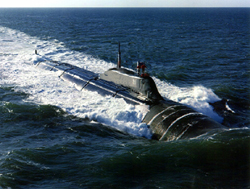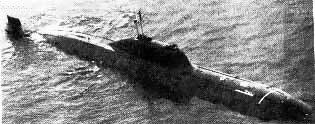

Designation:Warspite class Protoculture Attack Submarine |

|

|
|||

|
|||||
| SSP-1 Warspite | SSP-2 Sea Lion | SSP-3 Orzel |
| SSP-4 Amethyste | SSP-5 Silversides | SSP-6 Akula |
| SSP-7 Dolfijn | SSP-8 Surcouf | SSP-9 Bars |
| SSP-10 Nacken | SSP-9 Pantera | SSP-10 Wahoo |
| SSP-11 Herring | SSP-12 Ursula | SSP-13 Blackadder |
| SSP-14 Uzushio | SSP-15 Formidable | SSP-16 Drava |
| SSP-17 Humaita | SSP-18 Narhvalan | SSP-19 Nazario Sauro |
| SSP-20 Potvis | SSP-21 Vagsheer | SSP-22 Bleuback |
| SSP-23 Agosta | SSP-24 Barbel | SSP-25 Mistral |
| SSP-26 Narushio | SSP-27 Hai Long | SSP-28 Timbira |
| SSP-29 Oberon | SSP-30 Amberjack | SSP-31 Komsolomets |
| SSP-32 Iquique | SSP-33 Kursura | SSP-34 Heroj |
| SSP-35 Amazonas | SSP-36 Hai Pao | SSP-37 Najad |
| SSP-38 Okanagan | SSP-39 Collins | SSP-40 Salvatore Pelosi |
| SSP-41 Kobben | SSP-42 Okeanos | SSP-43 Eel |
| SSP-44 Splendid | SSP-45 Triton | SSP-46 Cakra |
| SSP-47 U-47 | SSP-48 Rahav | SSP-49 Utsira |
| SSP-50 Zwaardvis | SSP-51 Archangelsk | SSP-52 Takeshio |
| SSP-53 Rubis | SSP-54 Sculpin | SSP-55 Leonardo da Vinci |
| SSP-56 Onslaught | SSP-57 Nautilus | SSP-58 Le Redoutable |
| SSP-59 Abtao | SSP-60 Narval | SSP-61 Siroco |
| SSP-62 Ouessant | SSP-63 Ghazi | SSP-64 Barracuda |
| SSP-65 Burakreis | SSP-66 Antofagasta | SSP-67 Huancavilca |
| SSP-68 Kamehamea | SSP-69 Upholder | SSP-70 Sokol |
| SSP-71 Takashio | SSP-72 Onslow | SSP-73 Guglielmo Marconi |
| SSP-74 Ojibwa | SSP-75 Tijgerhaai | SSP-76 Santa Fe |
| SSP-77 Emeraude | SSP-78 Conqueror | SSP-79 Cavalla |
| SSP-80 Thresher | SSP-81 Hashmat | SSP-82 Murmansk |
| SSP-83 Speakhuggeren |
These ships were built at various shipyards in Russia, Western Europe, America and the Far East and entered service from 2005 through 2033. At present, only 8 ships (SSP-20, SSP-38, SSP-42, SSP-52, SSP-61, SSP-62, SSP-73 and SSP-83) remain service-worthy, all other boats have been destroyed during the Zentraedi Holocaust in port, were scrapped due to advanced age, scuttled after the Invid Invasion or wrecked in the Invid occupation.

The Warspite-class of submarine is an extensively modified version of the SSN-21 Seawolf submarine, as designed for the US Navy. The Warspite-class has a double hull construction, which added two meters to the Seawolf's beam, and about 12 meters to its length. This was, however, offset by the greatly increased damage control capacity, as well as by the fact that a lot of equipment could now be moved out of the pressure hull and into the space between the two hulls. In addition, far-reaching automation reduced the crew by a factor of one half, creating a very comfortable submarine.
The Warspite-class also used the new technology gleaned from the crashed SDF-1. The nuclear fission powerplant of the Seawolf was replaced with a protoculture powered Reflex Furnace. This also meant that the heavy reactor shielding could be disposed of, as could the intricate steam lines to and from the reactor and propulsion systems. The new system used two electric motors, fed directly from the furnace.
The propulsion system retained the Seawolf's propulsor, a ducted propeller, for speed, but also included two smaller, very quiet MHD drives for silent operations. Combining these systems, the Warspite and her sister ships can achieve a 'silent' speed of 24.5 knots. Of course, the more silent operation of the generators, compared with the pumps of the fission reactor, also lowered the emitted sound levels.
Improved hull materials increased the diving depth to twice that of the Russian Alpha-class attack submarine. This enabled the Warspite to dive under the maximum depth of many of the then-current torpedoes. In addition, the communication problems of submerged submarines were solved by the use of a low power hyperspace radio. This system could easily penetrate the deepest of Earth's oceans.
The Warspite-class was designed as an escort vessel for the new, high- value Prometheus and Daedalus submersible warships. The possible antagonist envisioned by the Navy was not an alien invader, but any faction that wanted to re-ignite the Global Civil War. Since the Prometheus- and Daedalus-classes were designed as surface warships that could submerge, their designs were not aimed on the traditional submarine features: stealth and ASW armament. In fact, the vessels were very noisy, and could be detected even by outdated submarine sonars at long ranges. They were, therefore, easy targets for hunter-killer submarines, though quite safe from orbiting starships. The Warspite-class was therefore designed and built in large numbers. In contrast to the design of the ships they were to escort, the Warspite-class used the new Reflex Furnaces rather than fission reactors. This was done because in this design stealth was the prime design criterion, and the furnaces were inherently more silent than the reactors.
The use of other products of the captured Tirolian technologies made these vessels the most lethal submarines ever. Use of Tirolian-inspired light-weight pressure-resistant metal alloys in the circular pressure hull gave the class increased depth capability, more so than their charges, who did not have circular hulls. In most of their operational areas, the Warspite class could reach the ocean floor, and also dive below the maximum depth of most anti-submarine weapons then in use. In addition, a more damage-resistant double hull and hydrodynamically shaped sail (on the urging of the Russian designers on the project) were used. This increased internal volume, and, coupled with a 50% reduction in the crew numbers, created the most roomy and livable submarine ever.
The class showed its merit after the Zentraedi Holocaust. Since all completed vessels of this class managed to dive before the attack, the class survived relatively intact. Only the units still on the building ways were destroyed. However, after the first years of reconstruction, the EBSIS was formed and adopted a more or less hostile attitude against the RDF. The Warspite boats, which had been laid up, were again commissioned and sent out to protect the Daedalus and Prometheus vessels against any EBSIS submarine that tried to interfere with their work as mobile bases against Zentraedi Malcontents. With the re-opening of the yards for extra Prometheus construction, the Warspite-class was again taken into series production also, and in total 82 units were built for the RDF and later for the Southern Cross Navy. These ships proved indeed to be the most efficient submarines ever designed, and not one of the Daedalus- and Prometheus-classes was ever damaged by EBSIS submarine.
Because of their nature, no actions were taken against the Robotech Masters in the Second Robotech war by the Warspites. On the other hand, no Warspites were ever sunk by Tirolian forces. Indeed, it is debatable whether the Masters knew of the existence of this class. The same did not go for the Invid. The Reflex Furnaces, which gave the class such superlative silent qualities, were quite detectable by Invid sensors. As a consequence, while all units survived the Invid invasion, they were attacked every time a boat tried to surface, or approach the shore. A few were indeed sunk, but most retreated to the deeper parts of the oceans. There they stayed as long as their supplies held out, but when those ran out, most boats set sail for the nearest coast on their batteries, were evacuated by their crew, and then settled on the bottom. Any attempt to move these vessels would require their furnace to light off, and thus lead to an Invid attack. A few of this class were found by the forces of Saxony in the Polyarnyy submarine bunkers, but suggestions to load them with nuclear cruise missiles and have them bombard the Invid from a safe distance were turned down by Saxony, since the CVS Demeter could do so herself, and does not need protoculture furnaces to get into launch position.
Return to RDF index
Go to Robotech Reference Guide Home Page.
Robotech (R) is the property of Harmony Gold. This document is in no way intended to infringe upon their rights.
Content by Pieter Thomassen, with Peter Walker
Copyright © 1998, 1997, 1995 Robert Morgenstern, Pieter Thomassen, Peter Walker
Last Updated: Tuesday, August 25, 1998 1:04 PM